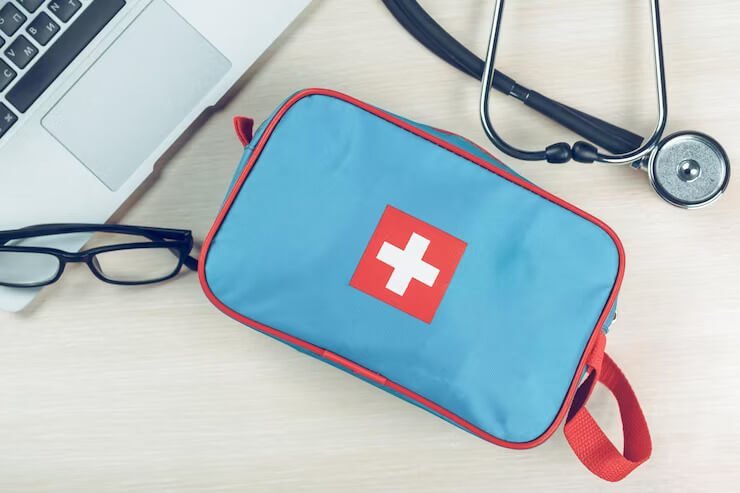Cardiovascular diseases are one of the leading causes of death globally. An astounding 356,000 people have out-of-hospital cardiac arrests (OHCA). Over 73% of all OHCA occur in homes, followed by 16.3% in public settings. Surprisingly, for the high number of out-of-hospital cardiac arrests happening at home, the survival rate is just 27.5%. In public places, the survival rate is 39.5%. These stats show how important it is to know how to administer Cardiopulmonary Resuscitation (CPR) and have an Automated External Defibrillator (AED) device on hand at home to save a life.
In 2023, when technology has progressed to a great level, it is unwise not to have lifesaving equipment on hand. Here is some essential lifesaving equipment that one must have in their home for any emergency fire or medical situation.
- AED Device
Given the number of cardiac arrest cases happening at home, it is now important to have an AED device in residences. Additionally, AED devices are now not very expensive, thanks to industries that have facilitated the mass manufacturing of medical equipment.
However, you need to make sure that you only go for reliable medical equipment manufacturers if you are willing to make the investment. Avive is a credible manufacturer and seller of AED devices.
Cardiac arrest is most common in men in their mid-30s to mid-40s. So, alongside keeping an AED device at home, it is also important that everyone learns how to administer CPR.
- Fire Extinguisher
In just three months, there have been 802 fatalities from home fires in the US in 2023. At home, cooking is the leading cause of the fire. 51.8% of home fires reported are caused because of cooking. Portable heaters and electrical equipment like dryers are also common causes of fires in residences.
Fire extinguishers are essential to control fire as soon as it erupts. Given that the people in the house know which fire extinguisher to use for which fire type and know how to use it, monetary damage, injuries, and fatalities can decrease drastically. Here’s a guide to help you determine which kind of fire extinguishers you should install at home and where to install them.
- Carbon Monoxide Detector
Carbon monoxide is a colorless, odorless gas. If you inhale it in large amounts, it can cause a “silent death”. In several homes, carbon monoxide leaks cause fatalities. These leaks can be caused by fireplaces, water heaters, and furnaces. Even your HVAC system is a possible cause of rising carbon monoxide levels in your house if it is not properly ventilated.
If you have a carbon monoxide detector at home, it consistently monitors the surroundings for signs of CO. It will alert you if there are dangerous levels of this gas present in your home. If you have an HVAC system that is not properly installed or a vent that is blocked, the CO detector in the house can be a lifesaver.
- Emergency Oxygen
There are many situations in which a person might struggle to breathe. If they have a severe allergic reaction, an asthma attack, a stroke, or a heart attack, they need oxygen to regulate their breathing. An AED device might help in regulating the person’s cardiac rhythm, but they might need oxygen too.
Providing oxygen to a heart attack patient can help improve the oxygen levels in their body, reducing the workload on the heart and protecting vital organs. So, it is wise to keep an emergency oxygen tank at home for cases of respiratory emergency. It can help keep them stable until medical help arrives. However, it is also important to learn how and when to use oxygen tanks, as improper use can lead to serious complications as well.
- Tourniquet
This lifesaving equipment is essential for people who live in remote locations or if they go hiking regularly to places where hospitals are not nearby. In case of an emergency, a tourniquet can help control the bleeding. It is important to use tourniquet for deep cuts, gashes, and punctures. A tourniquet is used as a last resort when other methods have failed.
So, it might not be an essential equipment to keep if you have some medical help located nearby. However, it is important for ambulances and places where people know how to use them properly to avoid further harm.
Other Must-Have Equipment at Home
A first aid kit is essential to have at home. It is not considered lifesaving equipment, but it can help deal with small injuries quickly. However, if you equip the kit with essentials that are lifesaving for your family, the first-aid kit becomes a lifesaver.
If you have someone at home who is allergic to certain foods, you should always have medication in your first aid kit that helps deal with the condition. For example, a person having a peanut allergy might have anaphylaxis, which is a severe and potentially life-threatening allergic reaction. This reaction can occur within minutes after exposure to peanuts. Therefore, having medication at home and in their bags is necessary to keep them out of danger.
Similarly, if someone has asthma, the home’s first aid kit should be equipped with a rescue inhaler, spacer, and a peak flow meter. The person should also have a rescue inhaler with them at all times in case there is a medical emergency.
Conclusion
Having essential lifesaving equipment at home can make all the difference in an emergency situation. The high number of out-of-hospital cardiac arrests happening at home highlights the importance of having an AED device and knowing how to administer CPR. Additionally, fire extinguishers, carbon monoxide detectors, emergency oxygen, and tourniquets can also be lifesaving equipment in various emergency situations.
It is important to invest in reliable equipment and learn how to use them properly to prevent further harm. By having these essential lifesaving equipment at home, we can increase the chances of survival in emergencies and minimize the risk of fatalities.

